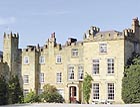History and High Jinks
Gyrn Castle has had its share of ups and downs, but is a fantastic addition to the market, finds Penny Churchill.


The 19th century opulence that was the hallmark of life at historic Gyrn Castle, at Llanasa, near Holywell, Flintshire, during the first half of the Bates shipping family's 150-year tenure, has all but disappeared following the dispersal of the house contents by Christie's on July 17 and 18. Now it remains for Strutt & Parker (01244 220500) and Jones Peckover (01745 812127) to find a buyer for the imposing, Grade II-listed, late-Georgian castle and its 367-acre estate overlooking the Dee Estuary and a resurgent Merseyside. A guide price of £3.5 million for the estate as a whole, with Gyrn Castle and its surrounding 103 acres of park, woods and farmland on offer at £2.5m.
Like so many grand houses, Gyrn Castle has had its shares of ups and downs. Once part of the estates of the Mostyns of Cilcain, Gyrn was sold in 1817 to John Douglas, a wealthy local cotton manufacturer, who spent the next seven years building the present castellated mansion on the site of an earlier house. The Douglas family later fell on hard times, and, in 1856, Gyrn was bought by Sir Edward Bates, a Liverpool ship owner and politician, who accumulated enormous wealth during a career spanning most of Queen Victoria's reign.
In 1957, Sir Geoffrey Bates, the fifth baronet, and the holder of an MC for bravery in World War II, inherited a Gyrn Castle estate much reduced by death duties, and moved there with his family. For 50 years until his death in February 2005, Sir Geoffrey worked tirelessly to develop the farming, shooting and fishing at Gyrn.
He also brought fun and laughter to Gyrn Castle, hosting numerous charity events and the annual Flint and Denbigh hunt ball in the spectacular, 29ft-high, picture gallery. In addition, the castle has three more grand reception rooms on the ground floor; six bedrooms, five bathrooms and a sitting room on the first floor; and a self-contained staff flat, and six further bedrooms on the second floor.
Sign up for the Country Life Newsletter
Exquisite houses, the beauty of Nature, and how to get the most from your life, straight to your inbox.
Country Life is unlike any other magazine: the only glossy weekly on the newsstand and the only magazine that has been guest-edited by HRH The King not once, but twice. It is a celebration of modern rural life and all its diverse joys and pleasures — that was first published in Queen Victoria's Diamond Jubilee year. Our eclectic mixture of witty and informative content — from the most up-to-date property news and commentary and a coveted glimpse inside some of the UK's best houses and gardens, to gardening, the arts and interior design, written by experts in their field — still cannot be found in print or online, anywhere else.
-
 Two quick and easy seasonal asparagus recipes to try this Easter Weekend
Two quick and easy seasonal asparagus recipes to try this Easter WeekendAsparagus has royal roots — it was once a favourite of Madame de Pompadour.
By Melanie Johnson
-
 Sip tea and laugh at your neighbours in this seaside Norfolk home with a watchtower
Sip tea and laugh at your neighbours in this seaside Norfolk home with a watchtowerOn Cliff Hill in Gorleston, one home is taller than all the others. It could be yours.
By James Fisher